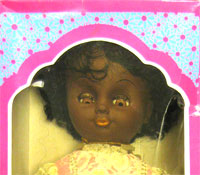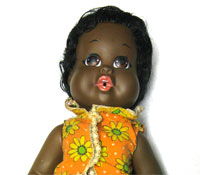Throughout the modern civil rights movement, the doll was a central metaphor of the negative effects of visual stereotypes. In the historic Brown v. Board of Education case, the NAACP offered testimony by an African American psychologist, Dr. Kenneth Clark, on a pioneering study he conducted in the late 1940s. African American grade-schoolers were shown separate drawings of black and white dolls, identical in every way except color. Individually, the children were asked which doll they preferred. The majority, viewing the black doll as “bad,” preferred the white doll and considered it “nice.”
Clark’s study confirmed that black children readily internalized the disapproving image of blackness then prevalent in all aspects of public life. Yet the toy industry, slow to recognize or acknowledge this problem, mostly ignored African American children. “Black dolls,” a tiny part of the market, were usually conventional white dolls fabricated in dark plastic. It was not until 1969 that the first mass-produced doll made specifically for black children was marketed. By contrast, the first “Black Barbie” doll was marketed in 1979, as the civil rights movement was drawing to an end.
Image Credits/Captions (Click on thumbnails for full image)
FS Toy Company, Hong Kong. June and Julie: The Musical Doll (African-American Version), 1965. June: 18 1/2 x 6 1/2 x 4 1/4 in. Julie: 7 x 3 1/4 x 2 in. Collection of Civil Rights Archive/CADVC-UMBC, Baltimore, MD, Anonymous Gift, 2008.5 a-c
Shindana Toy Company (Division of Operation Bootstrap), Watts, CA. “Baby Nancy” Doll, 1968. 13 1/4 x 6 1/4 x 3 1/2 in. Collection of Civil Rights Archive/CADVC-UMBC, Baltimore, MD, Anonymous Gift, 2008.4. Shindana Toys, a black-owned business founded in Los Angeles in 1968 as a division of the self-help organization Operation Bootstrap, mass-produced black dolls with “ethnically correct” features to countermand the harmful effects on African-American children of a market flooded with white- or dark-skinned dolls with Caucasian features.

